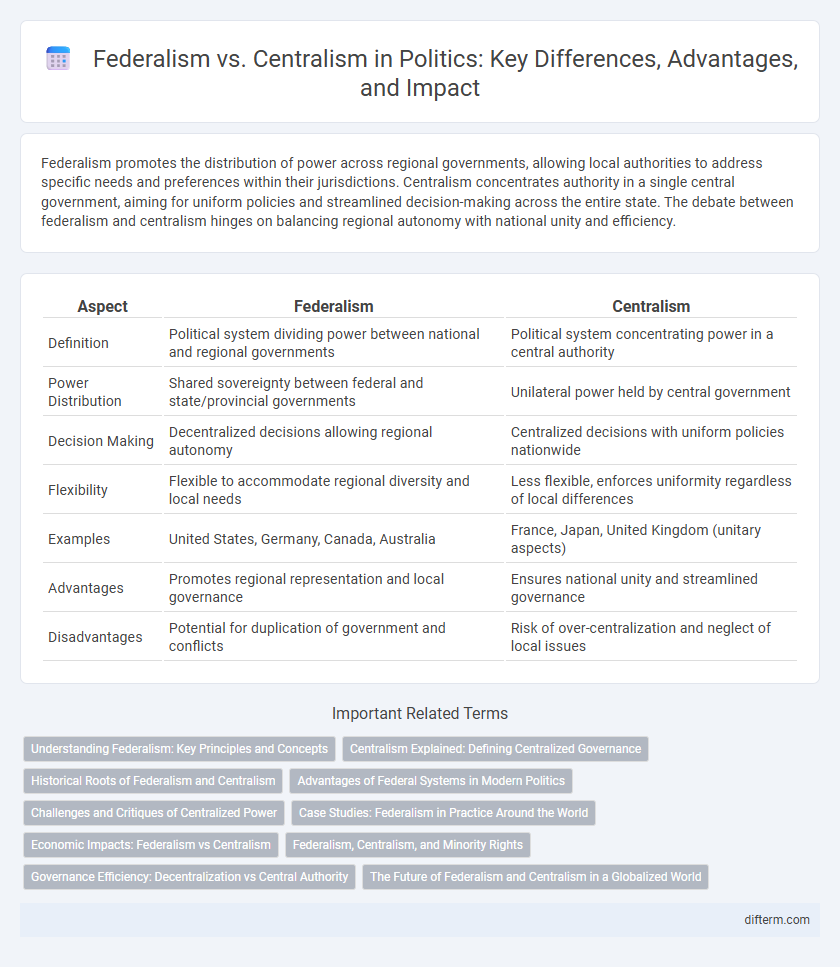Federalism promotes the distribution of power across regional governments, allowing local authorities to address specific needs and preferences within their jurisdictions. Centralism concentrates authority in a single central government, aiming for uniform policies and streamlined decision-making across the entire state. The debate between federalism and centralism hinges on balancing regional autonomy with national unity and efficiency.
Table of Comparison
| Aspect | Federalism | Centralism |
|---|---|---|
| Definition | Political system dividing power between national and regional governments | Political system concentrating power in a central authority |
| Power Distribution | Shared sovereignty between federal and state/provincial governments | Unilateral power held by central government |
| Decision Making | Decentralized decisions allowing regional autonomy | Centralized decisions with uniform policies nationwide |
| Flexibility | Flexible to accommodate regional diversity and local needs | Less flexible, enforces uniformity regardless of local differences |
| Examples | United States, Germany, Canada, Australia | France, Japan, United Kingdom (unitary aspects) |
| Advantages | Promotes regional representation and local governance | Ensures national unity and streamlined governance |
| Disadvantages | Potential for duplication of government and conflicts | Risk of over-centralization and neglect of local issues |
Understanding Federalism: Key Principles and Concepts
Federalism is a political system that divides power between a central government and regional or state governments, enabling autonomous decision-making within various jurisdictions. Key principles include decentralization, shared sovereignty, and constitutional division of powers, which promote local governance and accommodate diverse populations. Understanding federalism involves examining how authority is constitutionally allocated to balance unity with regional independence, contrasting with centralism's concentration of power in a single national government.
Centralism Explained: Defining Centralized Governance
Centralized governance concentrates political power within a single, central authority, enabling uniform policy implementation and streamlined decision-making across the entire nation. This system emphasizes national unity and coherence, often reducing regional autonomy to maintain control and consistency in governance. Centralism can facilitate efficient resource allocation but may limit local responsiveness and adaptability to diverse regional needs.
Historical Roots of Federalism and Centralism
The historical roots of federalism can be traced to the 18th-century United States Constitution, where a balance between state sovereignty and central authority was established to prevent tyranny. Centralism, on the other hand, has origins in European monarchies and Napoleonic France, emphasizing a strong, centralized government to maintain order and uniformity. These differing foundations continue to influence contemporary debates on governance structures and power distribution in modern nation-states.
Advantages of Federal Systems in Modern Politics
Federal systems distribute political power across multiple levels of government, enhancing local autonomy and allowing policies to reflect regional diversity more accurately. This decentralization promotes citizen participation by bringing government closer to the people, improving accountability and responsiveness. Federalism also fosters innovation, as states or provinces can experiment with policies that, if successful, may be adopted nationwide.
Challenges and Critiques of Centralized Power
Centralized power often faces challenges such as limited local autonomy, which can lead to inefficiencies in addressing regional needs and preferences. Critics argue that concentration of authority in a central government may result in bureaucratic rigidity, reduced accountability, and potential marginalization of minority groups. These issues fuel debates on the balance between national unity and regional diversity within political systems.
Case Studies: Federalism in Practice Around the World
Federalism is exemplified by countries such as the United States, Germany, and India, where power is constitutionally divided between national and subnational governments, enabling regional autonomy and diverse policy approaches. In contrast, centralist states like France concentrate authority within a strong central government, limiting the decision-making capacity of local entities. Case studies reveal that federalism often improves governance by accommodating cultural diversity and regional needs, while centralism emphasizes uniform national policies and streamlined administration.
Economic Impacts: Federalism vs Centralism
Federalism promotes economic diversity by allowing regions to tailor policies to local needs, fostering innovation and competition that can drive growth. Centralism centralizes fiscal control and resource allocation to achieve uniformity and reduce regional disparities but may stifle local initiative and adaptability. Economic outcomes hinge on balancing regional autonomy with national coordination to optimize resource distribution and market efficiency.
Federalism, Centralism, and Minority Rights
Federalism promotes the division of power between national and regional governments, allowing minority groups greater autonomy to preserve their cultural and political rights within a unified state. Centralism concentrates authority in a central government, often limiting regional self-governance and potentially marginalizing minority interests. Protecting minority rights under federalism involves constitutional guarantees and effective regional representation to ensure inclusive decision-making and prevent majoritarian dominance.
Governance Efficiency: Decentralization vs Central Authority
Decentralization under federalism enhances governance efficiency by allowing regional governments to tailor policies to local needs, leading to faster decision-making and increased accountability. Central authority in a unitary system enables uniform policy implementation and resource distribution, reducing duplication and potential conflicts between jurisdictions. Balancing these models depends on the complexity of a country's demographics, economic diversity, and administrative capacity.
The Future of Federalism and Centralism in a Globalized World
Federalism offers a decentralized approach that empowers regional governments, fostering local autonomy and tailored policy responses in an interconnected global landscape. Centralism, by contrast, prioritizes unified national authority, enabling streamlined decision-making and coherent strategies across borders amidst global challenges. The future balance between federalism and centralism will hinge on the ability of nations to integrate diverse regional interests while maintaining effective governance in an increasingly interdependent world.
federalism vs centralism Infographic

 difterm.com
difterm.com